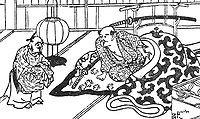
Yōsei (Japanese: 妖精, lit. "bewitching spirit") is a Japanese word that is generally synonymous with the English term fairy (フェアリー). Today, this word usually refers to spirits from Western legends, but occasionally it may also denote a creature from native Japanese folklore. For example, according to an old folk belief from Iwate Prefecture, it was once feared that the yōsei could resurrect the dead. It is also mentioned that the people of Mt. Hōrai are small fairies that have no knowledge of great evil and so their hearts never grow old. The Ainu also tell of a race of small people known as the Koro-pok-guru in their folklore. Another fairy-like being from Japan is the Kijimuna, tree sprites told in the Ryukyuan religion of Okinawa.
See also[edit]
- Yōkai – Supernatural beings from Japanese folklore
- Yaoguai – Creature from Chinese mythology
- Kobold – Sprite stemming from Germanic mythology
References[edit]
- "Definition: Yōsei". Daijirin Dictionary. Retrieved 2007-07-20.
- "Yōsei". Kaii-Yōkai Denshō Database. Retrieved 2007-07-20.
Well, that’s interesting to know that Psilotum nudum are known as whisk ferns. Psilotum nudum is the commoner species of the two. While the P. flaccidum is a rare species and is found in the tropical islands. Both the species are usually epiphytic in habit and grow upon tree ferns. These species may also be terrestrial and grow in humus or in the crevices of the rocks.
View the detailed Guide of Psilotum nudum: Detailed Study Of Psilotum Nudum (Whisk Fern), Classification, Anatomy, Reproduction